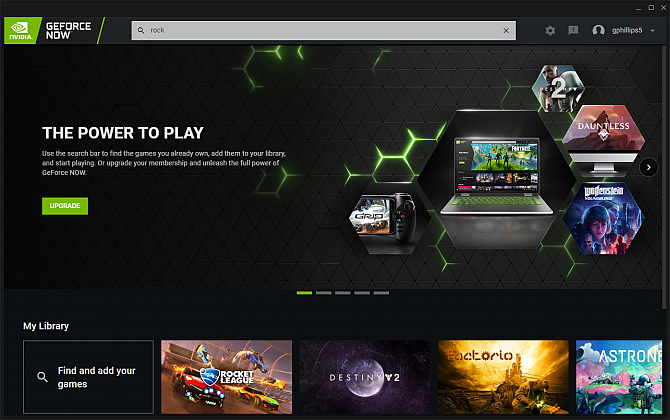Google Stadia is Google's cloud gaming service. It hit the headlines after its launch, as the service struggled with performance issues, a lack of content, and poor initial sales. Adding to Google's woe, graphics card manufacturing behemoth Nvidia is chasing Google Stadia down with the announcement that its GeForce Now streaming service is ready for consumers.
So, what is Nvidia GeForce Now? Is Nvidia GeForce Now better than Google Stadia?
What Is Nvidia GeForce Now?
Nvidia GeForce Now is a cloud gaming service that allows you to play your games on any compatible device. Nvidia's cloud gaming project was on the horizon before Google Stadia or Microsoft xCloud, but the project is only just moving out of beta and into the hands of consumers.
Like Google Stadia, you must own the game you want to play. However, the major difference is that Nvidia GeForce Now works with games you already own. Whereas, Google Stadia makes you purchase games within the Stadia ecosystem, which alone is causing consternation amongst critics.
Nvidia GeForce Now requires you to install a launcher on each device you want to play your games on. Once installed, you connect to your existing gaming platforms, such as Steam, then link which games you want to play. Once verified, you're free to play.
The launcher then boots into what looks like a virtual environment containing whichever platform you are using. You "install" the game (which takes seconds) and then you're good to go.
How Much Does Nvidia GeForce Now Cost?
Free to play is important, especially in this context. Nvidia GeForce Now offers a completely free, albeit limited tier.
The free tier allows you to cloud stream your game for one hour. After this, you must stop, restart your game, and then play on. The hour session includes a countdown timer, too, so your one-hour period doesn't end in the middle of a game.
There is a premium tier that costs $4.99 per month at the time of writing, though this price will rise in 12 months to a yet confirmed figure. The premium tier grants users six-hour cloud gaming sessions, in-game ray-tracing capabilities (where supported), and server priority access.
What Games Does Nvidia GeForce Now Support?
At the time of launch, Nvidia GeForce Now supports over 400 titles, with many more set to arrive in the short-term. There are some notable omissions, however. For instance, there are no titles from major developers like Square Enix (Final Fantasy, Tomb Raider, Hitman, etc.) or Rockstar Games (Grand Theft Auto, Red Dead Redemption, L.A. Noire, etc.).
Also, some games apparently available to the service don't work, such as Halo: Master Chief Collection, Monster Hunter, or Temtem. Furthermore, as I was writing this article, Activision Blizzard pulled all of their titles from GeForce Now. That means no Call of Duty, World of Warcraft, Hearthstone, Overwatch, or Sekiro. The loss of those titles is another blow for the service.
One thing is for sure, though. Even with the gaps, Nvidia GeForce Now already supports more games than Google Stadia. More titles are set to arrive, and those now removed titles could well return.
Does Nvidia GeForce Now Perform Well?
Initial reports suggest Nvidia GeForce Now is performing well, although as with any new service, there are kinks that require ironing out. Performance relates to your internet connection. GeForce Now requires at least 15Mbps for 720p at 60fps, and at least 25Mbps for 1080p at 60fps.
I trialed Nvidia GeForce Now with a few different games, all using Steam. My home internet connection isn't brilliant, as you will see in the following clips.
First up, Dirt Rally 2.0, a game I usually play on Ultra settings. As you can see, the resolution doesn't get above 720p, but the game is perfectly playable---despite my driving skills.
Second, Destiny 2, which is intensive in different ways. Here is the Destiny 2 Tower:
The colors aren't quite there, but the movement and vendor interactions are fine. However, the Tower is static, so here's how it looks in the European Dead Zone, with some in-game action:
Again, the colors are a little off. But you must remember that the issues come from my internet connection, rather than the GeForce Now platform.
Finally, Rocket League. How does the extremely fast-paced rocket-powered battle car soccer game hold up?
Rocket League depends on your connection speed. As mine is both cloud streaming the game and connecting to the Rocket League server, the overall gameplay is taking a hit.
As you would expect, your internet connection dictates your Nvidia GeForce Now experience. My home internet connection isn't great, so I have relatively poor resolution, and fast-paced games like Rocket League don't hold up well.
Aside from internet connection, Nvidia GeForce Now cloud gaming servers use custom Nvidia T10-8 GPUs. The T10-8 GPUs are based upon the TU102 die, which powers the Turing architecture found in powerful GPUs like the RTX 2080 Ti Super. The custom GPU is accompanied by a custom Intel CC150 CPU, with eight cores and 16 threads.
While that sounds incredible, GeForce Now users aren't getting an octa-core cloud gaming PC per person. A leaked GeekBench benchmark indicates the hardware is split between two instances. Each user has access to 4 cores and 8 threads, which is still a powerful cloud gaming platform.
Google Stadia Isn't All Bad!
Google Stadia has taken some pummelling. But the Google Stadia platform isn't all bad. In several areas, it is superior to GeForce Now.
The most obvious plus point for Stadia is the slick user interface. Menus load quickly and are easy to navigate---the ease of navigation ties into the simplistic approach of Google Stadia. You plug in the Chromecast Ultra, connect it to the Google Stadia app, and wait for your activation code. The design is easy enough that anyone can connect the dots and begin playing top-tier games without fiddling about or worrying about hardware. Stadia delivers on that.
Google also deserves a nod for the hardware powering Stadia. At the time of writing, Google Stadia cloud gaming servers run on custom 2.7GHz Intel CPU, with a custom AMD GPU based upon AMD Vega architecture. When AMD's Navi architecture rolls out, Google Stadia will almost certainly begin upgrading its cloud gaming servers, further boosting the overall gaming experience on offer. That's a decent hardware package that will continue to receive updates.
You should note the games available on Google Stadia, too. Remember how Red Dead Redemption, Tomb Raider, and other AAA games aren't available on Nvidia GeForce Now? You can find them on Google Stadia.
Google Stadia Performance
Although Google Stadia struggled with performance issues during its launch, many users are very happy with the gameplay on offer. MakeUseOf's Christian Cawley was "pleasantly surprised," finding "Crisp graphics, good sound quality, and responsive actions," making for a "tip-top gaming experience."
You can see some of Christian's Google Stadia in-game clips below, taken on a 45-50Mbps connection (which is similar to the connection I used for the Nvidia GeForce Now clips).
First up, Tomb Raider: Definitive Edition. The resolution and overall graphic fidelity are excellent, and the gameplay is smooth.
Second, rhythm-action rail-rider, Thumper. Again, fast and fluent gameplay that shows no impact concerning internet connection speed. You should also note how during the rapid transitions during Thumper, Google Stadia keeps the gameplay stable.
Finally, Samurai Showdown. The side-on fighting game is almost the same as its console release. The colors are accurate, there are absolutely no gameplay glitches, and you wouldn't know that you're using a cloud gaming platform.
Google Stadia's gameplay is fantastic. The service copes extremely well with a limited internet connection, ensuring a Google Stadia user can enjoy their game in high resolution.
That said, as with GeForce Now, it illustrates how important a fast internet connection is to getting the most out of any cloud gaming service. If you don't have the bandwidth, you won't have the premium experience.
Google Stadia vs. GeForce Now: What's the Best Cloud Gaming Platform?
There is one huge difference between Google Stadia and Nvidia GeForce Now, and it is crucial to how each cloud gaming platform will continue developing.
Google Stadia wants to replace your PC games and your consoles. Nvidia GeForce Now complements your existing game collection, rather than attempting to force you to part with it. That crucial difference is why critics are lauding Nvidia, and slating Stadia.
Most gamers already have an extensive collection of video games across Steam, Origin, GOG, and so on. Purchasing the same game to play on a cloud streaming platform is a waste of money at best and a ridiculous oversight by Google at worst. That's without considering the minute library on offer for Google Stadia, too.
There is the cost, too. Google Stadia requires specific hardware to access its cloud gaming platform, whereas Nvidia GeForce Now works using your existing hardware. Google Stadia costs $130 out of the box, plus an extra $70 for another controller. Then there is the monthly subscription of $9.99 to unlock premium streaming and other content, as well as the games you must buy on the Stadia platform to play.
Even if you only use GeForce Now to stream games from your PC to your main TV, the free tier is worthwhile.
Is Google Stadia Dead Before It Begins?
Google Stadia isn't what critics and users expected. It probably isn't exactly what Google envisaged, either. However, there is no way Google Stadia launched without the development team being fully aware of Nvidia GeForce Now. With cloud gaming platforms, the long game is important.
You only have to look at the remarks of Phil Spencer, executive vice-president of Gaming at Microsoft and head of the Xbox brand.
"When you talk about Nintendo and Sony, we have a ton of respect for them, but we see Amazon and Google as the main competitors going forward."
Google and Amazon are enormous in the cloud computing space, competing with Microsoft directly. Spencer realizes that a huge shift in the gaming space is lurking on the horizon. But not if Google cannot work out the issues with Stadia and not if Nvidia GeForce Now can continue the development of its awesome cloud gaming service.
Are you unsure about buying Google Stadia? Check out our hands-on Google Stadia review for an in-depth look at Google's cloud gaming service.


